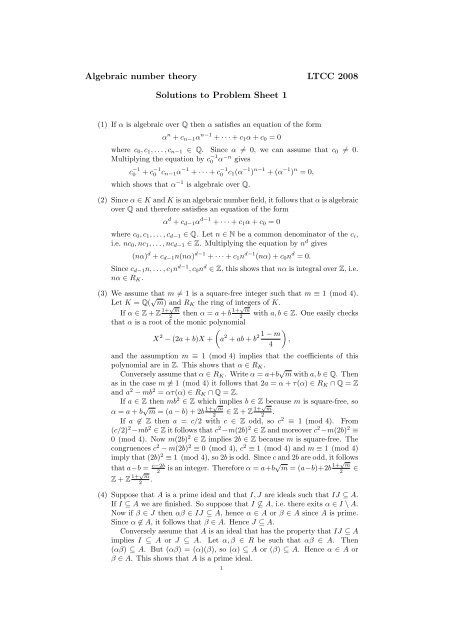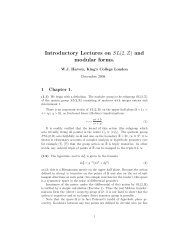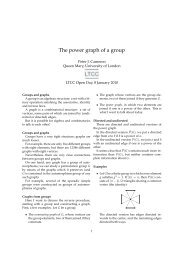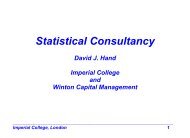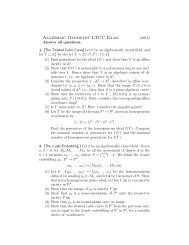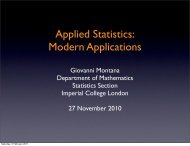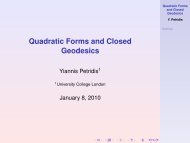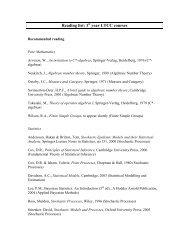Algebraic number theory LTCC 2008 Solutions to Problem Sheet 1
Algebraic number theory LTCC 2008 Solutions to Problem Sheet 1
Algebraic number theory LTCC 2008 Solutions to Problem Sheet 1
You also want an ePaper? Increase the reach of your titles
YUMPU automatically turns print PDFs into web optimized ePapers that Google loves.
<strong>Algebraic</strong> <strong>number</strong> <strong>theory</strong> <strong>LTCC</strong> <strong>2008</strong><br />
<strong>Solutions</strong> <strong>to</strong> <strong>Problem</strong> <strong>Sheet</strong> 1<br />
(1) If α is algebraic over Q then α satisfies an equation of the form<br />
α n + c n−1 α n−1 + · · · + c 1 α + c 0 = 0<br />
where c 0 , c 1 , . . . , c n−1 ∈ Q. Since α ≠ 0, we can assume that c 0 ≠ 0.<br />
Multiplying the equation by c −1<br />
0 α−n gives<br />
c −1<br />
0 + c −1<br />
0 c n−1α −1 + · · · + c −1<br />
0 c 1(α −1 ) n−1 + (α −1 ) n = 0,<br />
which shows that α −1 is algebraic over Q.<br />
(2) Since α ∈ K and K is an algebraic <strong>number</strong> field, it follows that α is algebraic<br />
over Q and therefore satisfies an equation of the form<br />
α d + c d−1 α d−1 + · · · + c 1 α + c 0 = 0<br />
where c 0 , c 1 , . . . , c d−1 ∈ Q. Let n ∈ N be a common denomina<strong>to</strong>r of the c i ,<br />
i.e. nc 0 , nc 1 , . . . , nc d−1 ∈ Z. Multiplying the equation by n d gives<br />
(nα) d + c d−1 n(nα) d−1 + · · · + c 1 n d−1 (nα) + c 0 n d = 0.<br />
Since c d−1 n, . . . , c 1 n d−1 , c 0 n d ∈ Z, this shows that nα is integral over Z, i.e.<br />
nα ∈ R K .<br />
(3) We assume that m ≠ 1 is a square-free integer such that m ≡ 1 (mod 4).<br />
Let K = Q( √ m) and R K the ring of integers of K.<br />
If α ∈ Z + Z 1+√ m<br />
2<br />
then α = a + b 1+√ m<br />
2<br />
with a, b ∈ Z. One easily checks<br />
that α is a root of the monic polynomial<br />
X 2 − (2a + b)X +<br />
(<br />
a 2 + ab + b 2 1 − m )<br />
,<br />
4<br />
and the assumption m ≡ 1 (mod 4) implies that the coefficients of this<br />
polynomial are in Z. This shows that α ∈ R K .<br />
Conversely assume that α ∈ R K . Write α = a+b √ m with a, b ∈ Q. Then<br />
as in the case m ≢ 1 (mod 4) it follows that 2a = α + τ(α) ∈ R K ∩ Q = Z<br />
and a 2 − mb 2 = ατ(α) ∈ R K ∩ Q = Z.<br />
If a ∈ Z then mb 2 ∈ Z which implies b ∈ Z because m is square-free, so<br />
α = a + b √ m = (a − b) + 2b 1+√ m<br />
2<br />
∈ Z + Z 1+√ m<br />
2<br />
.<br />
If a ∉ Z then a = c/2 with c ∈ Z odd, so c 2 ≡ 1 (mod 4). From<br />
(c/2) 2 −mb 2 ∈ Z it follows that c 2 −m(2b) 2 ∈ Z and moreover c 2 −m(2b) 2 ≡<br />
0 (mod 4). Now m(2b) 2 ∈ Z implies 2b ∈ Z because m is square-free. The<br />
congruences c 2 − m(2b) 2 ≡ 0 (mod 4), c 2 ≡ 1 (mod 4) and m ≡ 1 (mod 4)<br />
imply that (2b) 2 ≡ 1 (mod 4), so 2b is odd. Since c and 2b are odd, it follows<br />
that a−b = c−2b<br />
2<br />
is an integer. Therefore α = a+b √ m = (a−b)+2b 1+√ m<br />
2<br />
∈<br />
Z + Z 1+√ m<br />
2<br />
.<br />
(4) Suppose that A is a prime ideal and that I, J are ideals such that IJ ⊆ A.<br />
If I ⊆ A we are finished. So suppose that I ⊈ A, i.e. there exits α ∈ I \ A.<br />
Now if β ∈ J then αβ ∈ IJ ⊆ A, hence α ∈ A or β ∈ A since A is prime.<br />
Since α ∉ A, it follows that β ∈ A. Hence J ⊆ A.<br />
Conversely assume that A is an ideal that has the property that IJ ⊆ A<br />
implies I ⊆ A or J ⊆ A. Let α, β ∈ R be such that αβ ∈ A. Then<br />
(αβ) ⊆ A. But (αβ) = (α)(β), so (α) ⊆ A or (β) ⊆ A. Hence α ∈ A or<br />
β ∈ A. This shows that A is a prime ideal.<br />
1
2 <strong>Algebraic</strong> <strong>number</strong> <strong>theory</strong>, <strong>Solutions</strong> <strong>to</strong> <strong>Problem</strong> <strong>Sheet</strong> 1, <strong>LTCC</strong> <strong>2008</strong><br />
(5) Step 1: A 2 = (9, 7 + √ −14).<br />
We have<br />
A 2 = ( 3 · 3, 3 · (1 + √ −14), (1 + √ −14) · (1 + √ −14) )<br />
= (9, 3 + 3 √ −14, −13 + 2 √ −14).<br />
From this we see that<br />
9 = 1 · 9 + 0 · (3 + 3 √ −14) + 0 · (−13 + 2 √ −14) ∈ A 2 ,<br />
7 + √ −14 = (−1) · 9 + 1 · (3 + 3 √ −14) + (−1) · (−13 + 2 √ −14) ∈ A 2 ,<br />
hence (9, 7 + √ −14) ⊆ A 2 . Conversely, we have<br />
9 = 1 · 9 + 0 · (7 + √ −14) ∈ (9, 7 + √ −14),<br />
3 + 3 √ −14 = (−2) · 9 + 3 · (7 + √ −14) ∈ (9, 7 + √ −14),<br />
−13 + 2 √ −14 = (−3) · 9 + 2 · (7 + √ −14) ∈ (9, 7 + √ −14),<br />
hence A 2 ⊆ (9, 7 + √ −14).<br />
Step 2: A 4 = (5 + 2 √ −14).<br />
We have<br />
A 4 = ( 9 · 9, 9 · (7 + √ −14), (7 + √ −14) · (7 + √ −14) )<br />
= (81, 63 + 9 √ −14, 35 + 14 √ −14).<br />
From this we see that<br />
5 + 2 √ −14 = 3 · 81 + (−6) · (63 + 9 √ −14) + 4 · (35 + 14 √ −14) ∈ A 4 ,<br />
hence (5 + 2 √ −14) ⊆ A 4 . Conversely, we have<br />
81 = (5 − 2 √ −14) · (5 + 2 √ −14) ∈ (5 + 2 √ −14),<br />
63 + 9 √ −14 = (7 − √ −14) · (5 + 2 √ −14) ∈ (5 + 2 √ −14),<br />
35 + 14 √ −14 = 7 · (5 + 2 √ −14) ∈ (5 + 2 √ −14),<br />
hence A 4 ⊆ (5 + 2 √ −14).<br />
Step 3: A 2 is not principal.<br />
We define the norm of α = a+b √ −14 (with a, b ∈ Q) by Nα = a 2 +14b 2 .<br />
Then N(αβ) = Nα · Nβ (easy computation), and Nα ∈ N if α ∈ R K \ {0}.<br />
Now suppose that A 2 = (α) with α ∈ R K = Z + Z √ −14. Then 9 ∈ (α)<br />
implies that 9 = λα for some λ ∈ R K , hence 81 = N(9) = Nλ · Nα which<br />
shows that Nα | 81. Similarly 7+ √ −14 ∈ (α) implies Nα | N(7+ √ −14) =<br />
63. This shows that Nα = 1, 3 or 9. Write α = a + b √ −14 with a, b ∈ Z.<br />
Then Nα = a 2 + 14b 2 , so clearly Nα = 3 is impossible. If Nα = 9 then<br />
α = ±3. But clearly 7 + √ −14 ∉ (±3), so Nα = 9 is impossible. Finally<br />
if Nα = 1 then α = ±1 and therefore 1 ∈ (±1) = A 2 = (9, 7 + √ −14). So<br />
there exist v, w, x, y ∈ Z such that<br />
1 = (v + w √ −14) · 9 + (x + y √ −14) · (7 + √ −14)<br />
= (9v + 7x − 14y) + (9w + x + 7y) √ −14.<br />
Now 9v + 7x − 14y = 1 and 9w + x + 7y = 0 imply 1 = (9v + 7x − 14y) + 2 ·<br />
(9w + x + 7y) = 9 · (v + 2w + x) which is impossible. Hence the case Nα = 1<br />
is impossible. This completes the proof that there is no α ∈ R K such that<br />
A 2 = (α).<br />
Step 4: h K is divisible by 4.
<strong>Algebraic</strong> <strong>number</strong> <strong>theory</strong>, <strong>Solutions</strong> <strong>to</strong> <strong>Problem</strong> <strong>Sheet</strong> 1, <strong>LTCC</strong> <strong>2008</strong> 3<br />
Let [A] denote the class of the (fractional) ideal A in the class group<br />
Cl(K). By Step 2 the ideal A 4 is principal, thus [A] 4 = [A 4 ] is the identity<br />
element in Cl(K). It follows that the order of [A] in Cl(K) divides 4. But<br />
Step 2 shows that the ideal A 2 is not principal which implies that [A] and<br />
[A] 2 = [A 2 ] are not the identity element in Cl(K). Hence [A] has order 4 in<br />
Cl(K), and this implies that h K = |Cl(K)| is divisible by 4.<br />
(6) Clearly {1, −1, √ −1, − √ −1} ⊆ µ Q(<br />
√ −1) .<br />
Conversely assume that ζ ∈ µ Q(<br />
√ −1) . Then ζ ∈ R Q(<br />
√ −1) since ζ satisfies<br />
a polynomial equation of the form X e −1 = 0. So we can write ζ = a+b √ −1<br />
with a, b ∈ Z. Now ζ e = 1 implies |ζ| e = 1 where |ζ| = √ a 2 + b 2 is the usual<br />
absolute value of the complex <strong>number</strong> ζ, therefore |ζ| = 1. So a 2 + b 2 = 1<br />
and hence either a = ±1 and b = 0 which gives ζ = ±1, or a = 0 and b = ±1<br />
which gives ζ = ± √ −1. This shows µ Q(<br />
√ −1) ⊆ {1, −1, √ −1, − √ −1}.<br />
(7) If K = Q( √ m) for a square-free integer m > 1, then K is a real quadratic<br />
field, so K has two real embeddings and no complex embeddings, and µ K =<br />
{±1}. Therefore by Dirichlet’s unit theorem R × ∼ K = {±1}×Z. A unit ε ∈ R × K<br />
is a fundamental unit if and only if it is mapped <strong>to</strong> a genera<strong>to</strong>r of the <strong>to</strong>rsion<br />
free quotient R × K /µ ∼ K = ({±1} × Z)/{±1} ∼ = Z. It follows that there exist<br />
precisely four fundamental units: if ε is one fundamental unit, then the<br />
other three fundamental units are −ε, ε −1 and −ε −1 .<br />
Now let ε = x+y √ m with x, y ∈ Q be a fundamental unit of R × K . Clearly<br />
we must have x ≠ 0 and y ≠ 0. By Lemma 6.9 we know that N(ε) = (x +<br />
y √ m)(x−y √ m) = ±1, so ε −1 = (x+y √ m) −1 = (±x)+(∓y) √ m. But it is<br />
clear that of the four fundamental unit ε = x+y √ m, −ε = (−x)+(−y) √ m,<br />
ε −1 = (±x) + (∓y) √ m and −ε −1 = (∓x) + (±y) √ m precisely one is of the<br />
form a + b √ m with a > 0 and b > 0.<br />
If ε = a+b √ m is a fundamental unit with a, b > 0 and ε i = x+y √ m with<br />
i ≥ 2, then obviously x > a and y > b. Hence the fundamental unit ε can<br />
be characterised as the element with minimal a among all units a+b √ m for<br />
which a and b are positive. Therefore we can find ε by systematically trying<br />
a = 1, 2, 3, . . . (if m ≢ 1 (mod 4)) or a = 1 2 , 2 2 , 3 2<br />
, . . . (if m ≡ 1 (mod 4))<br />
until we find an a for which there exists an b such that a + b √ m ∈ R × Q( √ m) .<br />
Note that a + b √ m ∈ R × Q( √ m) implies N(a + b√ m) = a 2 − mb 2 = ±1, so it<br />
is easy <strong>to</strong> test whether such a b exists.<br />
In the case m = 7 ≢ 1 (mod 4) we have R Q(<br />
√<br />
7)<br />
= Z + Z √ 7. We try<br />
a = 1, 2, 3, . . . , and for each a we then test whether a 2 − 7b 2 = ±1 has a<br />
solution b ∈ N, i.e. whether (a 2 ∓ 1)/7 is a square of a positive integer. The<br />
first time this is the case is for a = 8 where we find (8 2 − 1)/7 = 3 2 . Hence<br />
ε = 8 + 3 √ 7 is a fundamental unit of Q( √ 7).<br />
Remark: There exists a much more efficient algorithm <strong>to</strong> find fundamental<br />
units of real quadratic fields by using continued fractions. For details see<br />
for example §5.7 in H. Cohen: A course in computational algebraic <strong>number</strong><br />
<strong>theory</strong>, Springer, 1993.<br />
(8) Choice of (r + s − 1) × (r + s − 1)-minor:<br />
Let v 1 , . . . , v r+s denote the rows of the matrix in Definition 6.12. We must<br />
show that the absolute value of the determinant of the matrix which is<br />
obtained by omitting the i-th row is independent of i. Recall from the<br />
proof of Lemma 6.10 that for every unit α we have<br />
log|σ 1 (α)| + · · · + log|σ r (α)| + 2 log|σ r+1 (α)| + · · · + 2 log|σ r+s (α)| = 0.
4 <strong>Algebraic</strong> <strong>number</strong> <strong>theory</strong>, <strong>Solutions</strong> <strong>to</strong> <strong>Problem</strong> <strong>Sheet</strong> 1, <strong>LTCC</strong> <strong>2008</strong><br />
Hence v 1 + · · · + v r+s = (0, . . . , 0). Therefore for every i = 1, . . . , r + s − 1<br />
we have<br />
⎛<br />
v 1<br />
⎞ ⎛<br />
⎞<br />
.<br />
.<br />
⎟<br />
⎜<br />
⎟<br />
det<br />
⎜<br />
⎝<br />
v i−1<br />
v i+1<br />
.<br />
v r+s−1<br />
v r+s<br />
= det<br />
⎟ ⎜<br />
⎠ ⎝<br />
⎛<br />
= det<br />
⎜<br />
⎝<br />
⎜<br />
= ± det ⎝<br />
v 1<br />
.<br />
.<br />
v i−1<br />
v i+1<br />
.<br />
v r+s−1<br />
−v 1 − · · · − v r+s−1<br />
⎞<br />
v 1<br />
.<br />
v i−1<br />
v i+1<br />
.<br />
v r+s−1<br />
−v i<br />
⎛<br />
⎟<br />
⎠<br />
v 1<br />
.<br />
v r+s−1<br />
⎞<br />
⎟<br />
⎠ .<br />
This shows that the absolute value of this determinant is independent of<br />
i. Hence the definition of the regula<strong>to</strong>r does not depend on the choice of<br />
(r + s − 1) × (r + s − 1)-minor.<br />
Choice of order of the embeddings:<br />
Changing the order of the embeddings only permutes the rows of the matrix,<br />
therefore the absolute value of the determinant of an (r +s−1)×(r +s−1)-<br />
submatrix does not change.<br />
Choice (and order) of fundamental units:<br />
Suppose that β 1 , . . . , β r+s−1 is another system of fundamental units for R × K .<br />
Then λ(α 1 ), . . . , λ(α r+s−1 ) and λ(β 1 ), . . . , λ(β r+s−1 ) are both Z-bases of the<br />
free abelian group λ(R × K ). Therefore we have λ(β j) = ∑ r+s−1<br />
i=1<br />
λ(α i )c ij with<br />
c ij ∈ Z. If C denotes the matrix (c ij ) 1≤i,j≤r+s−1 then<br />
Similarly<br />
⎟<br />
⎠<br />
(λ(β 1 ), . . . , λ(β r+s−1 )) = (λ(α 1 ), . . . , λ(α r+s−1 )) · C.<br />
(λ(α 1 ), . . . , λ(α r+s−1 )) = (λ(β 1 ), . . . , λ(β r+s−1 )) · D<br />
for an (r + s − 1) × (r + s − 1)-matrix D with entries in Z. It follows that<br />
CD is equal <strong>to</strong> the (r + s − 1) × (r + s − 1) unit matrix. In particular<br />
det(C) det(D) = 1, so det(C) = ±1 since these determinants are integers.<br />
Now the equation<br />
(λ(β 1 ), . . . , λ(β r+s−1 )) = (λ(α 1 ), . . . , λ(α r+s−1 )) · C.<br />
shows that an (r + s − 1) × (r + s − 1)-minor of the matrix with columns<br />
λ(β 1 ), . . . , λ(β r+s−1 ) is equal <strong>to</strong> det(C) times an (r+s−1)×(r+s−1)-minor<br />
of the matrix with columns λ(α 1 ), . . . λ(α r+s−1 ). Hence the absolute values<br />
of these minors are equal. This shows that the definition of the regula<strong>to</strong>r<br />
does not depend on the choice of system of fundamental units.


